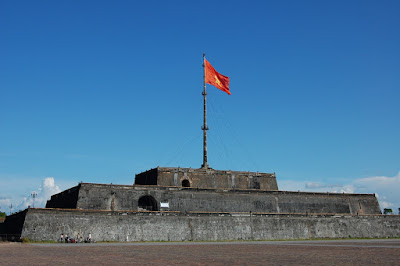On the 4-hour bus ride to Hoi An, we stopped briefly at a rest stop. In SE Asia, that means your tourist bus pulls up to a place selling cheap fried noodles and rice, cookies, candy and drinks. People wander around hawking bracelets, water, hats, you name it. This is also when everybody lights up their cigarettes, so I headed a block away from the rest stop and was rewarded with this view:
Once we made it to Hoi An, we set up shop at a cheap hotel. This was hard to find because Hoi An is apparently popular with well-heeled European tourists who are okay with paying $30-50 per night for a hotel room. After we found Hop Yen ($13 per night, although one of the worst places we've stayed-I'm pretty sure my "pillow" was actually a concrete brick), we set off to explore the town.
Although a smaller town of 120,000 on the central coast of Vietnam, Hoi An is beautiful and (surprise) a UNESCO World Heritage Site. In the 18th century, the town was a famous trading port, but its importance waned when nearby Da Nang became the center of trade.
Since Hoi An was forgotten for 200 years, the town is a well-preserved example of a Southeast Asia trading port from the 15th-19th centuries. It's also the first place I've visited in Vietnam that isn't peppered with ruins and destruction from our bombings in the Vietnam War.
Hoi An is also considered the best place in Vietnam for custom tailoring. There are over 500 tailor shops in the small town, where you can design any article of clothing, pick your fabric, and have it custom-made for you. Men's suits only cost about $50 and dresses are about $20-30.
The town is on the estuary of the Thu Bon River.
At night, lanterns illuminate the bridge over the river and all the streets and alleys.
There are beaches to visit nearby, but for our first day in Hoi An it was amazing to simply wander the lantern-lined roads.

























































